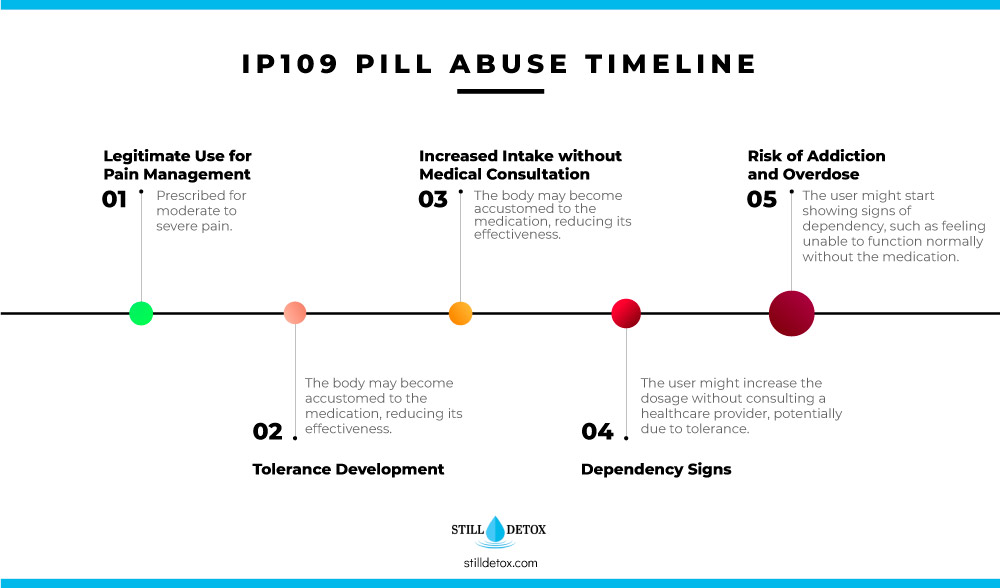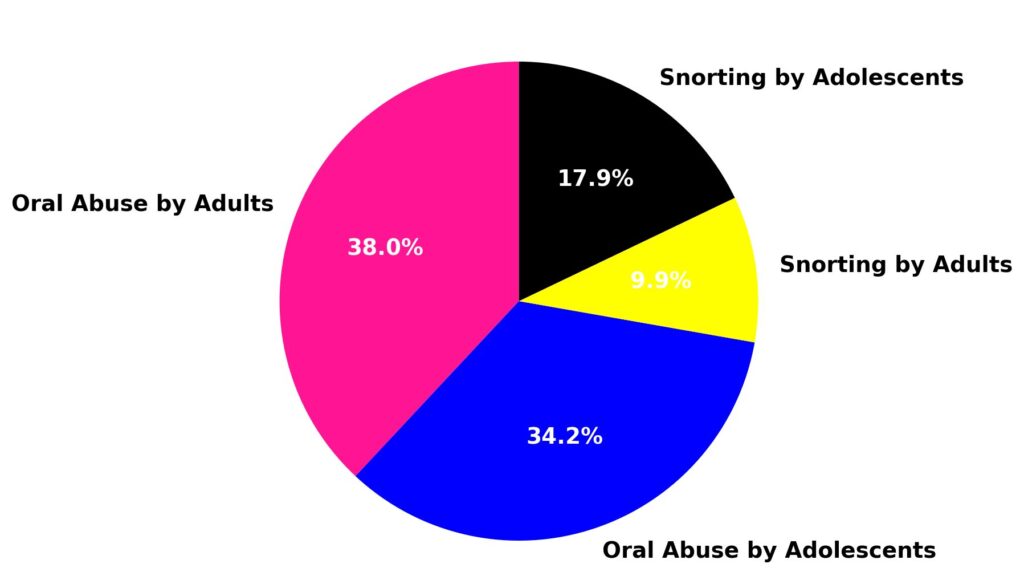Have you come across a white, capsule-shaped pill with “IP 109” printed on it? This medication is classified as an opioid analgesic, meaning it effectively provides pain relief. However, it is also a Schedule II controlled substance, indicating a high potential for abuse.
What Is IP 109 Pill?
The IP 109 pill is a white oblong tablet that combines 5mg of Hydrocodone bitartrate with 325mg of Acetaminophen. This formulation consists of Hydrocodone, a narcotic analgesic, and Acetaminophen, commonly known as the active ingredient in Tylenol, which acts as a pain reliever and fever reducer. While this combination is effective for pain relief, there is a potential risk of addiction, especially when IP 109 is prescribed for chronic pain.
Hydrocodone is notable for its role in the U.S. opioid crisis, serving both as a painkiller and a cough suppressant. It works by depressing the central nervous system and interacting with opioid receptors in the brain.
Acetaminophen, on the other hand, is effective for relieving mild to moderate pain and reducing fever and is the same active ingredient found in Tylenol. Generally considered safe when used as directed, it should be noted that high doses of Acetaminophen can lead to acute liver failure and allergic reactions.
As National Library of Medicine states, “Acetaminophen has been associated with cases of acute liver failure, at times resulting in liver transplant and death.
What Drugs Use the IP 109 Pill?
The Acetaminophen and Hydrocodone combination found in IP 109 is not unique to one brand. Several medications, both branded and generic, incorporate this combination. Notable brands such as Vicodin, Lortab, and Norco each contain this mixture, varying slightly in their compositions and concentrations of active ingredients.
What is the IP 109 Oval White Pill Used For?
IP 109 is predominantly prescribed for conditions requiring significant pain relief, like post-surgical discomfort or chronic conditions such as arthritis. It’s also occasionally used as a cough suppressant. Due to its potency, doctors typically advise a controlled dosage, emphasizing the importance of adhering to the prescribed amount to minimize risks.
How People Abuse IP 109?
Abuse of IP 109 occurs in various forms. While some individuals may consume the pill in higher doses than prescribed, others resort to alternative methods like snorting or injecting the crushed pill. These methods intensify the drug’s effects but also significantly increase the risk of severe side effects and overdose.
What Are the Risks of IP 109 White Pill Abuse?
Abusing the IP 109 white pill poses several risks. In the short term, misuse can result in symptoms like nausea, dizziness, and impaired judgment. Over the long term, the risks become more serious. The Acetaminophen component can cause liver damage, while the Hydrocodone can lead to hormonal imbalances and an increased risk of depression.
In addition to these, several other side effects can arise from misuse or taking excessive amounts of IP 109, such as:
- Drowsiness
- Confusion
- Extreme sleepiness
- Slow or shallow breathing
- Cold and clammy skin
- Pinpoint pupils
- Vomiting
- Respiratory depression
These side effects, particularly in severe cases, can lead to extreme consequences such as a coma, potential brain damage, and in the worst scenarios, death. It’s crucial to recognize these symptoms and obtain medical help immediately if they present themselves.
Addiction to IP 109
Hydrocodone, an active ingredient in IP 109 pills, is recognized as a Schedule II controlled substance due to its notable potential for addiction and abuse, as per the National Institutes of Health. Its risk level is somewhat lower than oxycodone, yet comparable to that of morphine.
A 2018 National Survey on Drug Abuse and Health report highlighted a concerning trend: hydrocodone products are the most frequently misused type of prescription painkillers. About 2% of Americans, roughly translating to 5.5 million people aged 12 and above, were found to have misused these products in the previous year.
Further insights from Pharmacoepidemiology and Drug Safety reveal how hydrocodone is misused. Most adults (90.3%) and adolescents (81.2%) misuse immediate-release hydrocodone combination products orally. Additionally, snorting is another method of misuse, reported by 23.4% of adults and a notably higher 42.5% of adolescents.
The long-term use of hydrocodone can lead to both physical and psychological dependencies. Often, individuals start taking hydrocodone products with no intention of misuse. But as tolerance to opioids develops quickly, they may increase their dose or frequency of use, leading to misuse and eventual dependency. This dependency can be challenging to overcome, as withdrawal symptoms emerge when the drug’s effects wear off, leading to a continuous cycle of abuse.
Tolerance and withdrawal symptoms are significant signs of addiction. The severity of opioid use disorder, as outlined in the APA’s DSM-5-TR, is determined based on the range and number of symptoms.
For those who are physically dependent on opioids like hydrocodone, stopping suddenly without medical guidance is not recommended, as it can lead to severe withdrawal symptoms. Although opioid use disorder is a complex condition, it often responds positively to a combination of proven treatments. Successful management of the disorder is possible with the right therapy and support.
Get Help for IP 109 Pill Addiction
Treating addiction to IP 109 requires professional intervention. This might include medically supervised detoxification, counseling, and support groups. The importance of seeking help cannot be overstated, as overcoming addiction alone can be incredibly challenging.
IP 109 Pill Overdose
Taking too much of the medication containing hydrocodone and acetaminophen like IP 109 can lead to some very serious and dangerous symptoms. These include:
- Slow, shallow breathing or difficulty breathing
- Drowsiness that progresses to unresponsiveness or coma
- Muscle weakness
- Cold, clammy skin
- Constricted (small) pupils
In some cases:
- Fluid buildup in the lungs
- Slow heart rate
- Low blood pressure
- Low blood sugar
- Partial or complete blockage of the airway
- Unusual snoring
- Even death
Interestingly, in overdose situations, the pupils may appear wide (dilated) rather than constricted, due to the effects of low oxygen levels. This is different from the usual constricted pupils seen with opioid overdoses.
Acetaminophen Overdose Symptoms and Risks
After an acetaminophen overdose, a person may experience symptoms like nausea, vomiting, sweating, and general feelings of being unwell. However, the signs of serious liver damage may not be evident until 2-3 days after the overdose occurred. Other complications can include kidney issues, low blood sugar, and blood clotting problems
How to React IP109 Pill Overdose?
In the event of an IP 109 overdose, it’s important to react quickly and effectively:
- Call Emergency Services Immediately: Dial emergency services, as an overdose involving hydrocodone can be life-threatening. Provide detailed information about the overdose, including the amount and time taken.
- Administer Naloxone: If you have naloxone available, administer it immediately. Naloxone is a medication that can help reverse an opioid overdose. Follow the instructions on the naloxone kit to properly administer it.
- Do Not Induce Vomiting: Unless directed by a healthcare professional, do not attempt to induce vomiting.
- Keep the Person Conscious: If the individual is awake, engage them in conversation and try to keep them responsive.
- Prepare Medication for Assessment: Have the pill bottle or any remaining pills ready for emergency responders.
- Do Not Give Food or Drink: Refrain from giving the person any food, drinks, or other medications unless advised by a healthcare provider.
- Monitor Vital Signs: Pay close attention to the person’s breathing and heart rate, and inform emergency responders of any distress.
Stay Calm and Supportive: Remain calm and reassuring while waiting for help.
A quick and proper response in the case of an overdose can save a life.
IP 109 Withdrawal Timeline and Symptoms
Hydrocodone withdrawal symptoms can start within 6 to 12 hours of the last dose and continue for up to 2 weeks. These symptoms can include muscle aches, nausea, diarrhea, cravings, anxiety, and depression.
On the milder end, individuals may experience symptoms like sweating and headaches. However, more intense withdrawal effects can also occur, including depression and severe pain. The duration and intensity of these symptoms largely depend on the extent of the individual’s IP 109 use and their unique physiological factors.
How Long Does IP 109 Pill Stay in Your System?
IP 109 can be detected in the blood for up to 24 hours after the last dose. Urine tests can identify the presence of the drug for approximately 3-4 days, though this can extend longer in cases of frequent use. Saliva tests have a shorter detection window, typically up to 1-2 days. Hair tests offer the longest detection period, capable of revealing drug use for up to 90 days or more.
It’s important to note that attempting to detox from IP 109 alone, without medical supervision, is not recommended. The process of eliminating IP 109 from the body can be complex and may require professional medical assistance to manage withdrawal symptoms safely and effectively.
Painkiller Addiction Treatment Program at Still Detox Luxury Rehab
At Still Detox Luxury Rehab, a specific Painkiller Addiction Treatment Program is offered, focusing on the challenges faced by individuals addicted to painkillers, including the IP 109 white pill. This comprehensive program addresses the unique aspects of addiction to painkillers like IP 109, which contains hydrocodone, a potent opioid. Key features of the program include:
Medical Detox: The program begins with a medically supervised detox, tailored to safely wean clients off IP 109, while managing withdrawal symptoms in a controlled environment.
Individualized Treatment Plans: Understanding that addiction is a personal experience, each client receives a treatment plan designed specifically for their needs, considering their history with IP 109 and other substances.
Behavioral Therapies: A core component of the program involves various behavioral therapies. This includes Cognitive Behavioral Therapy (CBT), which helps in identifying and altering negative thought patterns related to addiction.
Group and Individual Counseling: The program offers both individual and group counseling sessions to provide peer support and personal guidance, facilitating discussions about the challenges and experiences with painkiller addiction.
Medication-Assisted Treatment (MAT): MAT can be an integral part of the treatment for IP 109 addiction, helping to reduce cravings and normalize body functions without the negative effects of the opioid.
Holistic Approaches: To support overall wellness, holistic therapies such as yoga, meditation, and acupuncture are incorporated, aiding in stress reduction and promoting mental clarity.
Relapse Prevention Training: Patients learn skills and strategies to prevent relapse, including how to cope with triggers and cravings specific to painkiller addiction.
Aftercare Support: Ongoing support is vital. The program offers continued therapy and access to support groups post-treatment, ensuring long-term sobriety.
The Painkiller Addiction Treatment Program at Still Detox Luxury Rehab in Boca Raton, Florida maintains a strict focus on effective recovery from addiction to painkillers like the IP 109 white pill, ensuring that our patients receive the best possible care in a setting that promotes healing, comfort and privacy.
Call Now
(561) 556-2677
Sources:
- National Library of Medicine Hydrocodone and Acetaminophen
- APA Understanding and overcoming opioid abuse
- NIH Hydrocodone
- NIHPrescription opioid analgesics rapidly change the human brain
- Healthline Does Acetaminophen in Medications Hurt Your Liver?
- WebMD Acetaminophen and Your Liver: What’s Safe?








